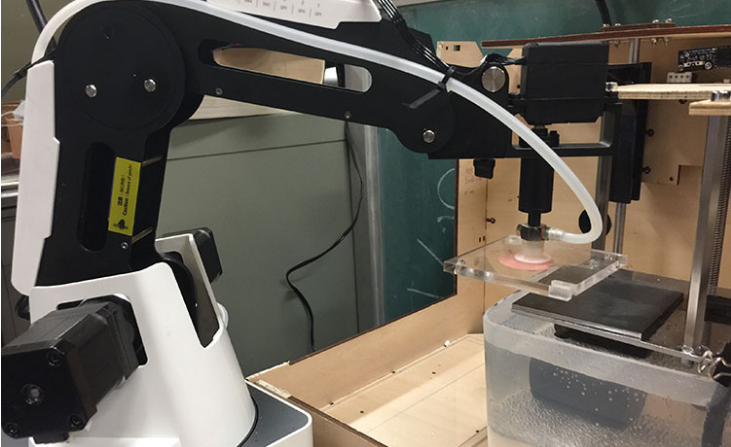 UC Berkeley engineers may have finally found a realistic way to 3D print human organs. In their recently published paper, ‘A parallel multiple layer cryolithography device for the manufacture of biological material for tissue engineering,’ authors Gideon Ukpai, Joseph Sahyoun, Robert Stuart, Sky Wang, Zichen Xiao, and Boris Rubinsky explain how they have been able to speed up 3D printing with additional hardware and robotic arms working at rapid speed. Extreme temperatures also become a major quotient for cell sustainability.
UC Berkeley engineers may have finally found a realistic way to 3D print human organs. In their recently published paper, ‘A parallel multiple layer cryolithography device for the manufacture of biological material for tissue engineering,’ authors Gideon Ukpai, Joseph Sahyoun, Robert Stuart, Sky Wang, Zichen Xiao, and Boris Rubinsky explain how they have been able to speed up 3D printing with additional hardware and robotic arms working at rapid speed. Extreme temperatures also become a major quotient for cell sustainability.
Researchers today may be able to extract cells and have an excellent concept for manipulating them, but their fragility often ends a promising project before it even begins. With all these issues in mind, scientists have created a new system that uses freezing temperatures and an exponential amount of printing power to gain speed in production—basically, before cells have a chance to die and ruin everything:
“The technology uses multilayer cryolithography (MLCL) to make biological products faster and in larger quantities by simultaneously printing 2D layers in parallel and assembling the layers into a 3D structure at an assembly site, instead of sequentially and linearly assembling a 3D object from individual elements as
While consistent temperature and chemistry are vital to keeping cells alive, cryolithography here adds a novel twist, freezing each layer—and offering a better chance for sustainability.
“The problem with 3D bioprinting is that it is a very slow process, so you can’t print anything big because the biological materials will deteriorate by the time you finish,” said Boris Rubinsky, professor of mechanical engineering and leader of the team that designed the device. “One of our innovations is that we freeze the material as it is being printed so that the biological material is preserved, and we can control the freezing rate.”
Often referred to as the holy grail of bioprinting, researchers see fabrication of organs as the end goal. This could extend the lifetimes of so many patients currently waiting for transplants, and in the future, allow doctors to offer extraordinary medical treatment. With this new technology, researchers have even more control over production, temperature, and sustainability.
“As each layer is stacked to form a 3D structure, one of the innovations we implemented was to dip the 3D structure into a cryogenic bath to freeze it rather than having the bath fill up to meet each layer,” said Joseph Sahyoun (Meng ’18, ME) and co-author on the paper. “This method allowed us to control the freezing rate more accurately.”
The new system could translate into better quality in the food preparation arena also, due to the high-performance technique in freezing.
“This is important because the size of the ice crystals and the homogeneity of the ice crystals are a central element in the quality of the frozen food,” said Boris Rubinsky, professor of mechanical engineering and co-author of the paper.
“Dysphagia is very common among the geriatric population. Because these patients have difficulty swallowing, they are being fed food that is basically mush, so they don’t have an appetite, and the problem exacerbates,” said Rubinsky. “But if you can create food with texture, this may be more appetizing. Then as they chew, the food will melt in their mouth so they can swallow and get the nutrients. Our technology allows you to do that with any kind of food.”
This new form of printing has enormous potential within the entire industry, but especially the realm of tissue engineering—one of the hottest areas of research today. And while bioprinting is obviously making huge strides for the medical field, this project serves as one more example of the many different forms of refinement being addressed within 3D printing. Over the past few years, innovations within 3D software, hardware, and materials have escalated like technological dominoes—and they don’t seem to be stopping anytime soon.
Researchers continue to find ways to keep cells alive long enough to successfully engineer tissue, whether for fabrication in the lab of a lung, bladder, or even a cellularized heart. Find out more about how robotics is pushing 3D printing technology further forward here.
(Video courtesy of Gideon Ukpai, UC Berkeley)
[Source: Berkeley Engineering; Berkeley News]
Subscribe to Our Email Newsletter
Stay up-to-date on all the latest news from the 3D printing industry and receive information and offers from third party vendors.
You May Also Like
3D Printing Webinar and Event Roundup: April 28, 2024
In this week’s 3D Printing Webinar and Event Roundup, the Ceramics Expo is taking place in Michigan, Stratasys continues its advanced training courses, and SPE is holding a Polymer Characterization...
Initial Speakers and Sponsors Announced for Additive Manufacturing Strategies 2025
Nearly a year away from the event, the Additive Manufacturing Strategies (AMS) 2025 conference is already beginning to take shape. Building upon the success of 2024’s summit, AMS has established...
HP & INDO-MIM Collaborate to Boost Metal 3D Printing in India
HP Inc. and INDO-MIM, a US- and India-based supplier of metal injection molding (MIM) powders and contract manufacturer, have announced that the two companies will collaborate to accelerate additive manufacturing...
One of US’s Largest Machine Tool Resellers to Offer Stratasys 3D Printing
In a key move for the additive manufacturing (AM) stalwart, Stratasys (Nasdaq: SSYS) has announced a strategic partnership with Select Additive Technologies, a division of Morris Group, Inc., which is...

































